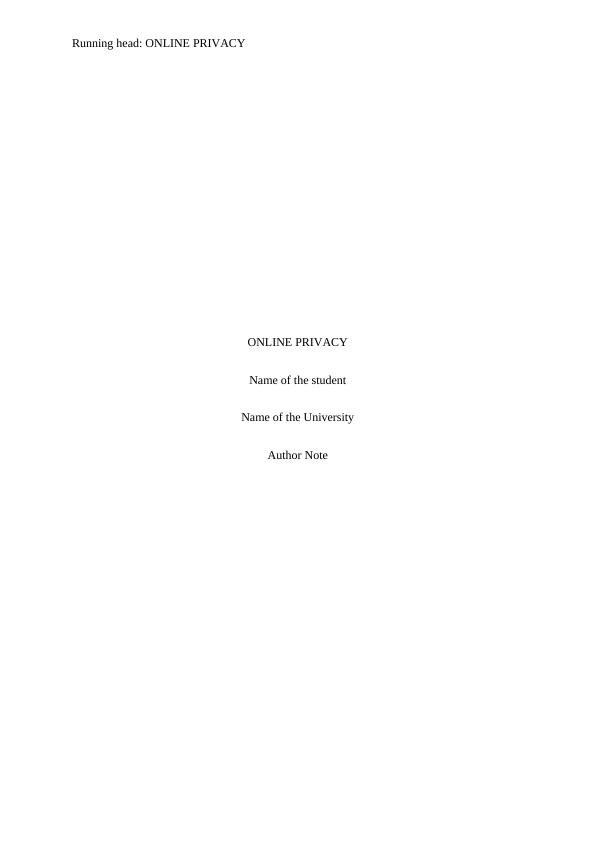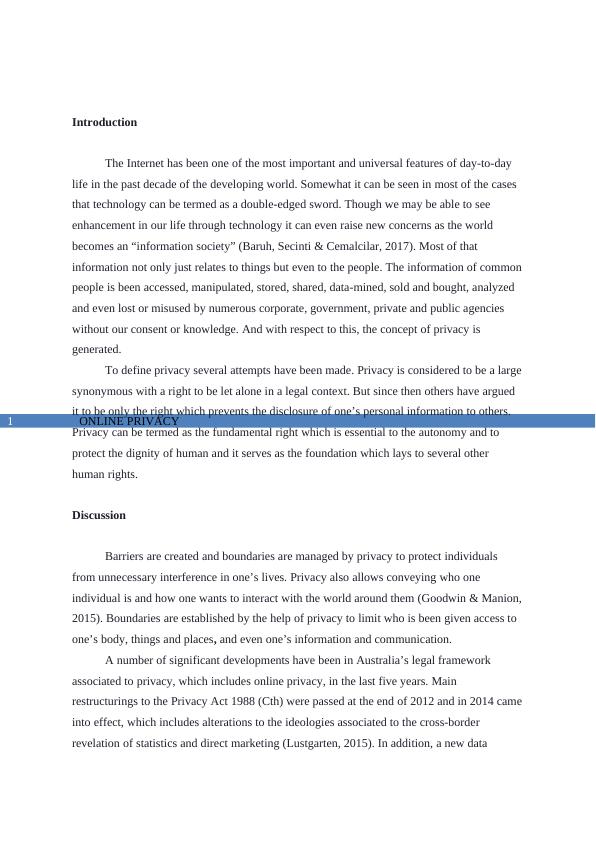Online Privacy Assignment 2022
Added on 2022-09-17
7 Pages2308 Words31 Views
Running head: ONLINE PRIVACY
ONLINE PRIVACY
Name of the student
Name of the University
Author Note
ONLINE PRIVACY
Name of the student
Name of the University
Author Note

ONLINE PRIVACY1
Introduction
The Internet has been one of the most important and universal features of day-to-day
life in the past decade of the developing world. Somewhat it can be seen in most of the cases
that technology can be termed as a double-edged sword. Though we may be able to see
enhancement in our life through technology it can even raise new concerns as the world
becomes an “information society” (Baruh, Secinti & Cemalcilar, 2017). Most of that
information not only just relates to things but even to the people. The information of common
people is been accessed, manipulated, stored, shared, data-mined, sold and bought, analyzed
and even lost or misused by numerous corporate, government, private and public agencies
without our consent or knowledge. And with respect to this, the concept of privacy is
generated.
To define privacy several attempts have been made. Privacy is considered to be a large
synonymous with a right to be let alone in a legal context. But since then others have argued
it to be only the right which prevents the disclosure of one’s personal information to others.
Privacy can be termed as the fundamental right which is essential to the autonomy and to
protect the dignity of human and it serves as the foundation which lays to several other
human rights.
Discussion
Barriers are created and boundaries are managed by privacy to protect individuals
from unnecessary interference in one’s lives. Privacy also allows conveying who one
individual is and how one wants to interact with the world around them (Goodwin & Manion,
2015). Boundaries are established by the help of privacy to limit who is been given access to
one’s body, things and places, and even one’s information and communication.
A number of significant developments have been in Australia’s legal framework
associated to privacy, which includes online privacy, in the last five years. Main
restructurings to the Privacy Act 1988 (Cth) were passed at the end of 2012 and in 2014 came
into effect, which includes alterations to the ideologies associated to the cross-border
revelation of statistics and direct marketing (Lustgarten, 2015). In addition, a new data
Introduction
The Internet has been one of the most important and universal features of day-to-day
life in the past decade of the developing world. Somewhat it can be seen in most of the cases
that technology can be termed as a double-edged sword. Though we may be able to see
enhancement in our life through technology it can even raise new concerns as the world
becomes an “information society” (Baruh, Secinti & Cemalcilar, 2017). Most of that
information not only just relates to things but even to the people. The information of common
people is been accessed, manipulated, stored, shared, data-mined, sold and bought, analyzed
and even lost or misused by numerous corporate, government, private and public agencies
without our consent or knowledge. And with respect to this, the concept of privacy is
generated.
To define privacy several attempts have been made. Privacy is considered to be a large
synonymous with a right to be let alone in a legal context. But since then others have argued
it to be only the right which prevents the disclosure of one’s personal information to others.
Privacy can be termed as the fundamental right which is essential to the autonomy and to
protect the dignity of human and it serves as the foundation which lays to several other
human rights.
Discussion
Barriers are created and boundaries are managed by privacy to protect individuals
from unnecessary interference in one’s lives. Privacy also allows conveying who one
individual is and how one wants to interact with the world around them (Goodwin & Manion,
2015). Boundaries are established by the help of privacy to limit who is been given access to
one’s body, things and places, and even one’s information and communication.
A number of significant developments have been in Australia’s legal framework
associated to privacy, which includes online privacy, in the last five years. Main
restructurings to the Privacy Act 1988 (Cth) were passed at the end of 2012 and in 2014 came
into effect, which includes alterations to the ideologies associated to the cross-border
revelation of statistics and direct marketing (Lustgarten, 2015). In addition, a new data

ONLINE PRIVACY2
preservation structure was conventional, becoming fully operative in early 2017, with internet
service providers obligatory to recollect certain records about online communications that can
then be retrieved by government agencies for enforcement of law and national security
purposes. An advance legislative modification in 2017 established a constraint for objects
enclosed by the Privacy Act to inform pretentious persons and the Information Commissioner
of data gaps. The Privacy Act comprises 13 Australian Privacy Principles (APPs), which
apply to certain private segment associations, as well as most Australian Government
agencies. These are cooperatively denoted as ‘APP entities’. The Privacy Act also controls
the privacy section of the customer credit reporting system, tax file numbers, and health and
medical research.
Several challenges in preservation are brought along with the growth of the
pervasiveness of digital media. Due to the short lifespan the digital materials are at a higher
risk level than the analog materials. The issues and challenges raised around digital materials
are Data volumes, the biggest challenge in increasing digitized world is the huge lump of data
that impact all the challenges and hence making it more complex and inherently larger
(Montgomery, Chester & Milosevic, 2017). The storage cost, ongoing maintenance and
downloading is more with the increase of volume of data. A second fundamental issue is
Archivability which defines what data should be preserved. The challenge here is the extent
of preservation like for what time period a data should be preserved depending on the
relevancy of the data in use. The third issue in digital media is Multiplicity this implies that
data may be present in multiple forms of the same or either different versions. Like an image
can be uploaded to iCloud, uploaded on Facebook or any other social media thus it increases
the issue to archive the original file and thus leading the data to be not of the same quality as
the real or original file.
Hardware and software failure is another issue which may result in the detrition of digital
material such as digital media stored in hard disk or USB are prone to deterioration than the
analog media. In software the data of certain file format which can be only opened in a
certain software if that software is deprecated thus it may be a huge issue to access the data
after a certain time. Thus having data of open format makes it easier to access. The most
important aspect of digital preservation is metadata. Digital materials with poor metadata
result in making the data undiscoverable and making the authenticity unverifiable. Thus the
data will not be useable and the missing or inadequate metadata even impact on rendering.
To ensure data privacy one needs to secure their device and networks and to do so
several methods can be adopted like encrypting the data, data encryption makes it more
preservation structure was conventional, becoming fully operative in early 2017, with internet
service providers obligatory to recollect certain records about online communications that can
then be retrieved by government agencies for enforcement of law and national security
purposes. An advance legislative modification in 2017 established a constraint for objects
enclosed by the Privacy Act to inform pretentious persons and the Information Commissioner
of data gaps. The Privacy Act comprises 13 Australian Privacy Principles (APPs), which
apply to certain private segment associations, as well as most Australian Government
agencies. These are cooperatively denoted as ‘APP entities’. The Privacy Act also controls
the privacy section of the customer credit reporting system, tax file numbers, and health and
medical research.
Several challenges in preservation are brought along with the growth of the
pervasiveness of digital media. Due to the short lifespan the digital materials are at a higher
risk level than the analog materials. The issues and challenges raised around digital materials
are Data volumes, the biggest challenge in increasing digitized world is the huge lump of data
that impact all the challenges and hence making it more complex and inherently larger
(Montgomery, Chester & Milosevic, 2017). The storage cost, ongoing maintenance and
downloading is more with the increase of volume of data. A second fundamental issue is
Archivability which defines what data should be preserved. The challenge here is the extent
of preservation like for what time period a data should be preserved depending on the
relevancy of the data in use. The third issue in digital media is Multiplicity this implies that
data may be present in multiple forms of the same or either different versions. Like an image
can be uploaded to iCloud, uploaded on Facebook or any other social media thus it increases
the issue to archive the original file and thus leading the data to be not of the same quality as
the real or original file.
Hardware and software failure is another issue which may result in the detrition of digital
material such as digital media stored in hard disk or USB are prone to deterioration than the
analog media. In software the data of certain file format which can be only opened in a
certain software if that software is deprecated thus it may be a huge issue to access the data
after a certain time. Thus having data of open format makes it easier to access. The most
important aspect of digital preservation is metadata. Digital materials with poor metadata
result in making the data undiscoverable and making the authenticity unverifiable. Thus the
data will not be useable and the missing or inadequate metadata even impact on rendering.
To ensure data privacy one needs to secure their device and networks and to do so
several methods can be adopted like encrypting the data, data encryption makes it more

End of preview
Want to access all the pages? Upload your documents or become a member.
Related Documents
Report on Information Technology Profession and Ethicslg...
|8
|2113
|400
Cyber Intelligence Sharing and Protection Actlg...
|6
|1944
|44
Online Privacy: Protecting Your Personal Data and Securitylg...
|8
|2203
|260
Online Privacy and Protection: A Comprehensive Guidelg...
|9
|1935
|200
IT Profession and Ethicslg...
|7
|2127
|453
IT Profession and Ethics: Importance of Online Privacy and Protection Measureslg...
|8
|2043
|334
